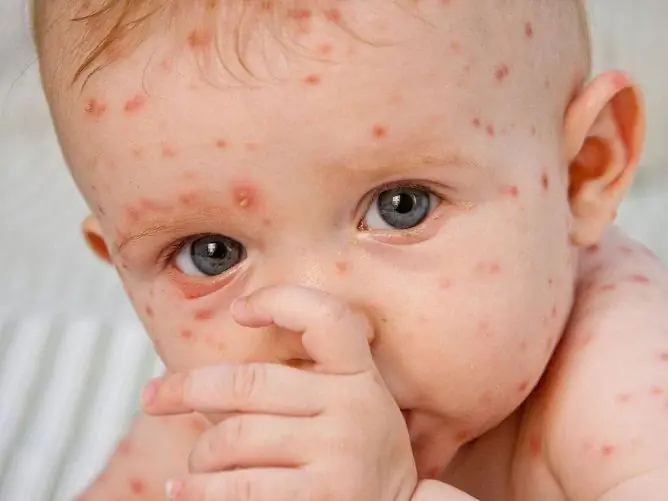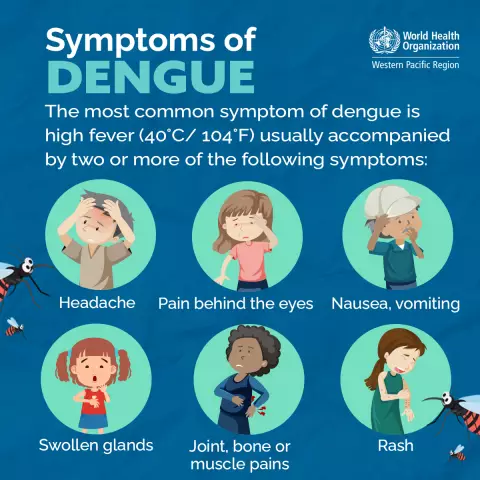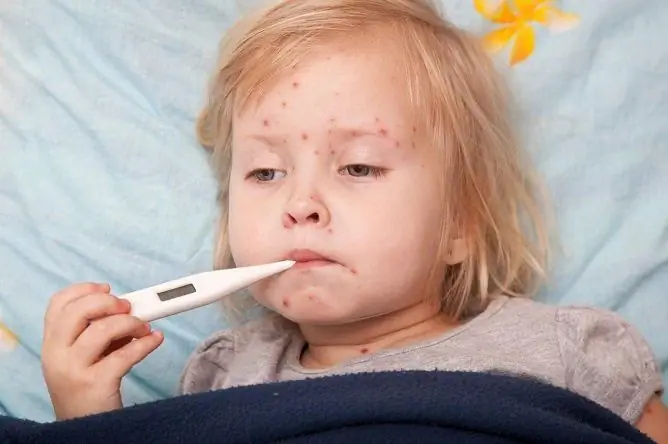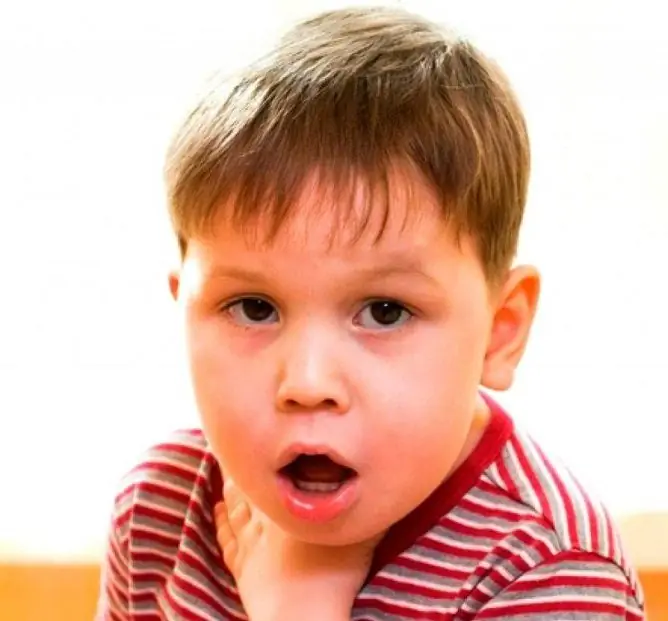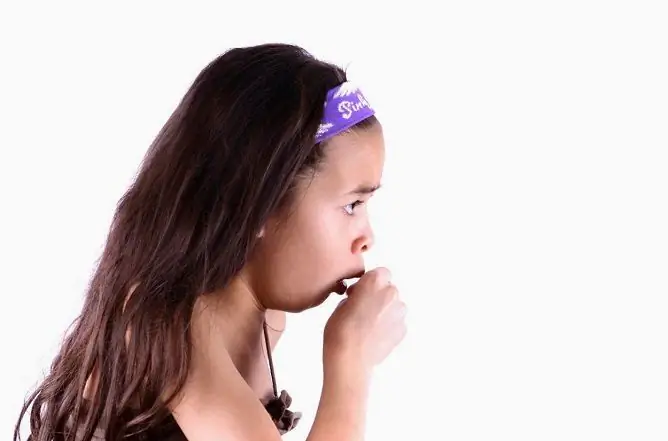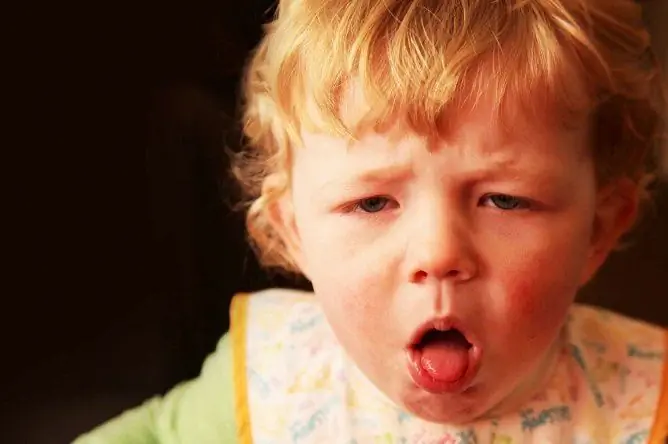- Author Rachel Wainwright [email protected].
- Public 2024-01-15 19:51.
- Last modified 2025-11-02 20:14.
Is it possible to walk with chickenpox?
The content of the article:
-
Doctor's advice
- Recommendations for mild disease
- How long is the walking restriction valid?
- Conservation regime depending on the form of chickenpox
- Overview of Chicken Pox
- Video
Chickenpox is a typical acute infectious disease of childhood caused by a virus from the Herpesviridae family - Varicella Zoster, characterized by fever and a macular vesicular rash. Due to the extreme infectiousness, it will be an infectious disease doctor or a pediatrician to determine whether it is possible to walk with chickenpox (on what day from the onset of the disease).

Even if the child is feeling well, it is not recommended to walk with chickenpox.
Doctor's advice
Since chickenpox is an extremely contagious infectious disease, general rules must be followed:
- Walking with chickenpox in a child without fever is prohibited throughout the entire period of fresh rashes. This period is on average 5-7 days from the moment the last element of the vesicular rash appears (with the exception of atypical forms).
- The parents of the child isolate him at home in order to limit the spread of infection (the route of transmission is through the air, the infectivity is almost 100%). Frequent ventilation is acceptable in the room where the child is. No specific disinfection is required.
- It is necessary to limit walking with the baby in case of direct contact with a sick person for an average of 10-21 days (the incubation period of the disease). This limitation is due to the fact that the child becomes infectious to others 2 days before the first clinical signs of the disease (rash, fever) appear.
- The risk of contracting chickenpox through close contact with an infected person in open areas is minimal. But the restrictions are imposed, since the child is in public places for a short time before getting on the street (entrance, elevator).
- It is required to limit the child's attendance at kindergarten and school for the entire period of illness and for the duration of the incubation period due to the impossibility of excluding the risk of infection.
- On the street in winter with chickenpox, a child should go out only after all the crusts have fallen off (7-10 days after the last rash). Why? This limitation is imposed for a preventive purpose, since in winter the skin is exposed to low temperatures, therefore, it becomes more fragile. Cold exposure somewhat slows down the healing process of the vesicles and can lead to their injury with the formation of a scar.
- Restriction on walking is also imposed in order to minimize trauma to the vesicles. In the case of self-healing, they disappear without a trace, but if the crust or element of the rash is torn off, an atrophic scar forms in its place, which can only be removed by surgical methods.
Recommendations for mild disease
Many parents are interested in the question of whether it is possible to walk with children with chickenpox, given the lack of temperature and other visible manifestations of the disease. Pediatricians, including the famous doctor Komarovsky, believe that even with a mild course of the disease, you should not go for a walk with your child. Thus, in the case of a mild course of the disease with minimal rashes, the rules remain the same - the possible contact of a sick child with healthy children should not be allowed.
How long is the walking restriction valid?
The general symptoms of the disease in children with chickenpox rarely lasts throughout the entire period of the disease, and usually disappear within 1-2 days of the rash. However, a decrease in temperature is not an indicator of recovery and it is necessary to maintain a protective regime until the bubbles gradually become covered with a crust (people remain infectious until all lesions are covered with it).
During the period of drying of the crusts, when there are no new rashes (7-10 days), you can go out with the child for short walks, but you must adhere to the following recommendations:
- In the summer, you can not swim in water due to the risk of infection through injured skin.
- You should not resume physical activity in full immediately after the illness. It is optimal to gradually increase the walking time over 2 weeks until the individual returns to normal.
Conservation regime depending on the form of chickenpox
Currently, the classification proposed by V. N. Timchenko is more often used. (2001):
- Typical shape.
- Atypical forms: rudimentary, pustular, bullous, hemorrhagic, gangrenous, generalized.
The typical form of chickenpox
Has all the typical clinical manifestations of chickenpox (rash, fever, intoxication). Classic guard mode required:
- a ban on walking for the entire period of the rash (5-7 days);
- a ban on walking and visiting school or kindergarten for everyone who came into contact with the patient, for a period of 10-21 days.
Atypical forms of chickenpox
In this case, the incubation period is similar to the typical form, and the differences lie in the elements of the rash and the severity of the course of the disease.
| The form | Features: | Preventive measures |
| Rudimentary | It is characterized only by sporadic rashes. There is no temperature or intoxication. The mildest form of the disease. | The limitations are the same as for the typical shape, even if there is no temperature. |
| Pustular | Associated with a complication - the addition of a secondary infection; the contents of the vesicles become cloudy and purulent. | The restriction on walking is increased from 5-7 days from the moment of rash to 9-11 days with a preventive purpose, since it takes more time for the healing of purulent foci to reduce the risk of additional infection. |
| Bullous | In addition to the typical vesicles, large flaccid blisters (bullae) form on the skin. | The protective regime should be increased to 10 days from the moment of the rash, instead of the prescribed 5-7. This is done taking into account the tendency of bulls to spontaneously open and become infected. |
| Hemorrhagic |
It develops more often in children suffering from hemoblastosis or hemorrhagic diathesis. The contents of the blisters become bloody for 2-3 days. |
In view of the possibility of spontaneous hemorrhages in the skin and mucous membranes, a stationary protective regime is indicated for 10-15 days with a ban on walking. |
| Gangrenous | Associated with inflammation and tissue rejection. Ulcers with a "dirty" bottom and undermined edges are formed. Ulcers can coalesce to form significant defects. | In view of the increased risk of infection and an extremely serious condition, a stationary protective regime is shown for 15-20 days with a ban on walking. |
| Generalized | It develops more often in newborns from mothers who have not had chickenpox. It is characterized by neurotoxicosis and vesicular eruptions on the internal organs. | Extremely severe form with a high risk of death. The protective regime is selected strictly individually and is more than 20 days. Inpatient treatment only. |

Walking for children with chickenpox is allowed on average a week after the appearance of the last rashes
Overview of Chicken Pox
Some features of the disease:
- Rarely occurs in newborns and children in the first years of life. In this group of patients, infection is possible only in case of intrauterine infection (TORCH infection) or at birth from HIV-infected mothers, when there is no natural protection by maternal antibodies.
- For prophylaxis or for suspected chickenpox infection, attenuated varicellar-zoster vaccines can be used. After vaccination, there is no protective regime (walks and visits to the garden or school are allowed).
- After the transferred infection, stable lifelong immunity is formed.
- An adult, pregnant and lactating women, as well as persons with immunodeficiency constitute a risk group, since their chickenpox is extremely difficult, even fatal is possible.
Video
We offer for viewing a video on the topic of the article.

Anna Kozlova Medical journalist About the author
Education: Rostov State Medical University, specialty "General Medicine".
Found a mistake in the text? Select it and press Ctrl + Enter.

